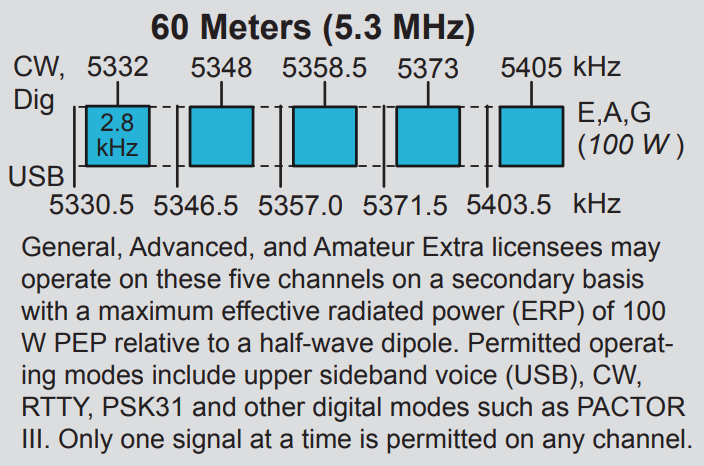First introduced in 2002, the 60 meter, or 5 MHz, band was originally only available in a few countries: United States, United Kingdom, Norway, Finland, Denmark, Ireland, and Iceland.
Over the years, an increasing number of countries’ telecommunications authorities have permitted amateur radio operations in the 5 MHz band. Allocations range from discrete channels to an entire frequency band.
Currently, radio amateurs in the U.S. have access to five discrete channels on a secondary basis.
Below is the U.S. 60M Band Plan from the ARRL:

Last year the ARRL asked hams to urge the Federal Communications Commission (FCC) to continue the existing use of the 60-meter band. A public comment period open until late November 2023 allowed amateurs to express support for the current 100 W ERP power limit (instead of reducing the power limit to 15 W EIRP) and continuing secondary access to the current channels.

From Wikipedia regarding 60 meters:
“In the United States and its territories and possessions, channelized USB is mandatory. Where channelization is used, the USB suppressed carrier frequency (a.k.a. ‘dial’ frequency) is normally 1.5 kHz below the quoted channel frequency. For example, 5403.5 kHz is the ‘dial’ frequency for the channel centered on 5405 kHz. The ‘center’ of the channel is based on the assumption that the bandwidth of SSB transmissions is 3 kHz, at most. Transmitters that are capable of wider SSB bandwidths should be adjusted for 3 kHz bandwidth or less, so their emissions stay within the allocated channel.”
Modes permitted:
- USB Voice
- CW
- RTTY
- Data: This includes any digital mode modulated in a single sideband transmitter, with a bandwidth of 2.8 kHz or less whose technical characteristics have been documented publicly, per Part 97.309(4) of the FCC Rules. Such modes would include PACTOR I, II or III, 300-baud packet, MFSK, MT63, Contestia, Olivia, DominoEX, FT8, and others
Some 60M Ham Radio History
The ARRL explains why the FCC gave amateur operators channels instead of a band:
“The National Telecommunications and Information Administration (NTIA), which administers spectrum regulated by the federal government, raised eleventh-hour opposition to ARRL’s request and the FCC’s proposal that would have given amateurs a 150-kHz wide band at 5 MHz (5250 to 5400 kHz). The NTIA’s opposition, expressed after the period for comments already had expired, cited ongoing spectrum requirements of federal government licensees having homeland security responsibilities. Following some give and take between the FCC and the NTIA, the latter agency reviewed its assignments in the vicinity of 5 MHz and found five “lightly used” channels it felt could be shared. Contrary to speculation elsewhere, the channels are no harbinger of a new trend in Amateur Radio allocations in general. This is a special case.”
***
Questions? Share them in the comments below or email me at KE8FMJ@gmail.com.

